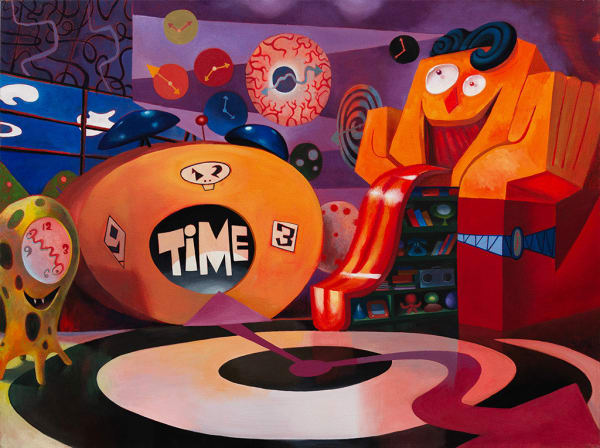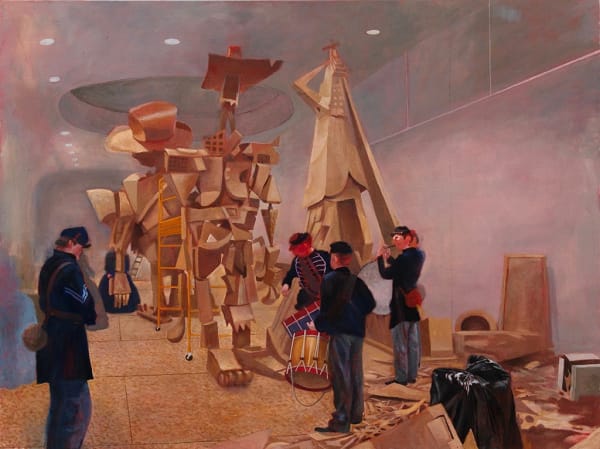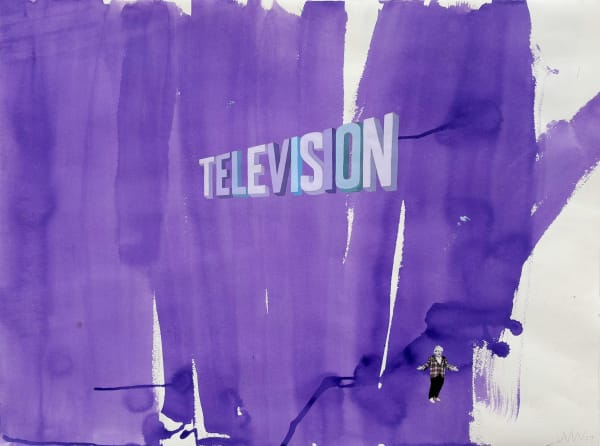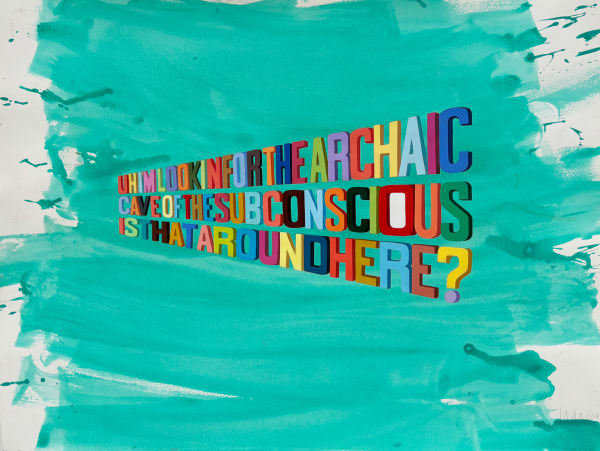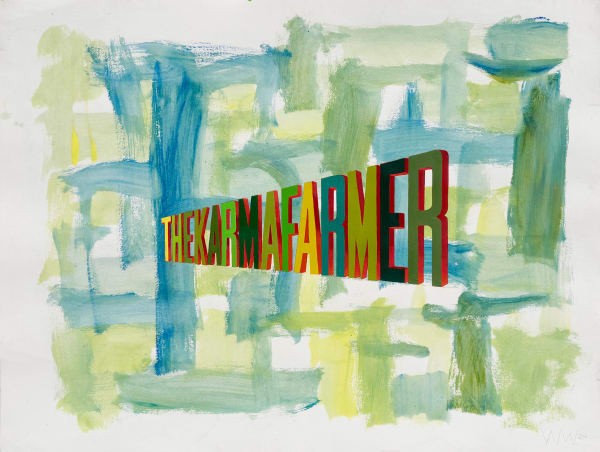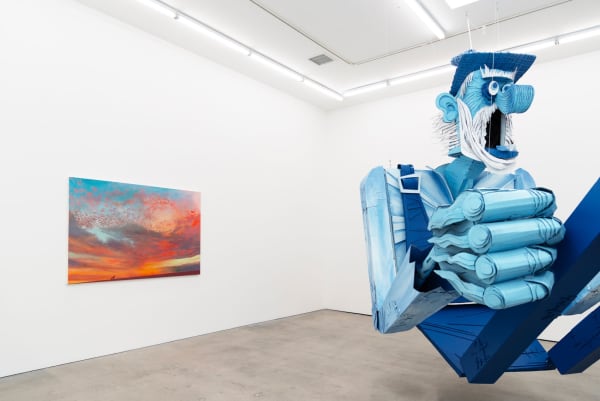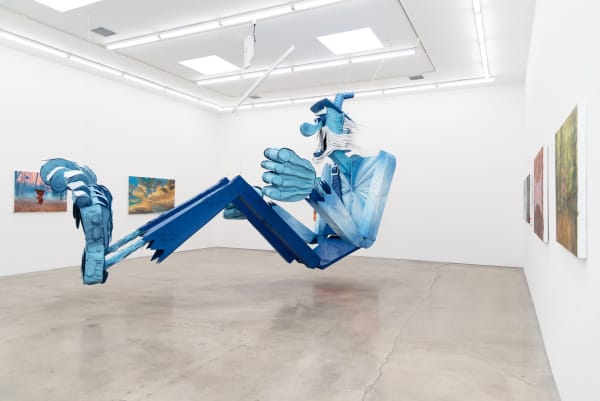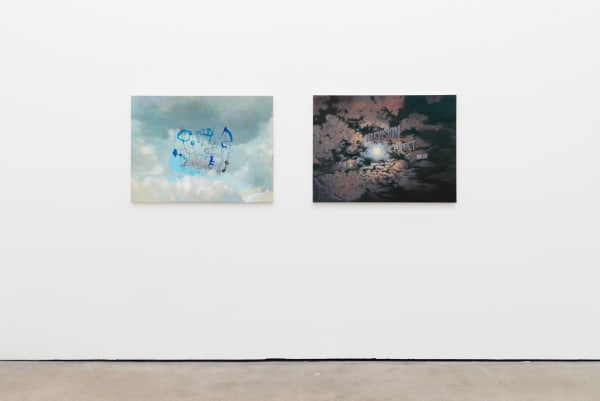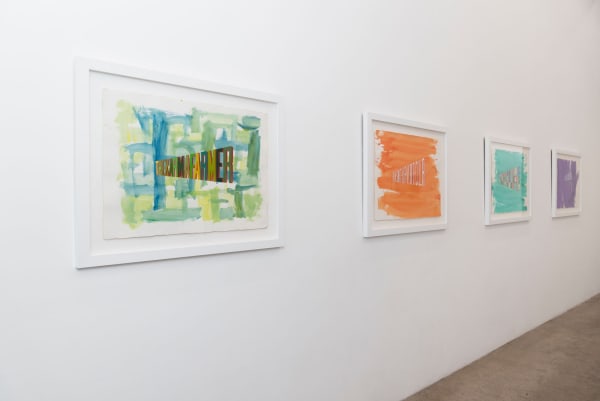Wayne White - "Jumping From Ice Floe to Ice Floe"
Hashimoto Contemporary is pleased to present Jumping from Ice Floe to Ice Floe, the first solo exhibition of prolific artist and designer Wayne White at Hashimoto Contemporary. The exhibition is curated by Heather Hakimzadeh, curator of the Virginia Museum of Contemporary Art.
Opening Night Reception:
Saturday, May 18th
6pm - 8 pm
Gallery Hours:
Tuesday - Saturday / 10am - 6pm
Hashimoto Contemporary LA
2754 S La Cienega Blvd.
Los Angeles, CA 90034
Advance Collector's Preview:
An advance collector's preview will be made available online before the exhibition opens, if you would like to receive a price list, please contact us at la@hashimotocontemporary.com.
- X
- Tumblr
 Wayne White, Sand Mountain, 2024
Wayne White, Sand Mountain, 2024 Wayne White, Escape, 2024
Wayne White, Escape, 2024 Wayne White, HumanFuckinKnowledge, 2024
Wayne White, HumanFuckinKnowledge, 2024 Wayne White, Jumping from Ice Floe to Ice Floe, 2024
Wayne White, Jumping from Ice Floe to Ice Floe, 2024 Wayne White, I STRADDLE THE GREAT BRINY BAY AND WARM MY HANDS OVER THE ANXIETY RADIATING FROM THE CITY’S CORE, 2024
Wayne White, I STRADDLE THE GREAT BRINY BAY AND WARM MY HANDS OVER THE ANXIETY RADIATING FROM THE CITY’S CORE, 2024 Wayne White, Drawing, 2024
Wayne White, Drawing, 2024 Wayne White, Television Puppet Show, 2024
Wayne White, Television Puppet Show, 2024 Wayne White, Chickamauga II, 2024
Wayne White, Chickamauga II, 2024 Wayne White, Mrs Cabobbles Caboose, 2024
Wayne White, Mrs Cabobbles Caboose, 2024 Wayne White, Chickamauga I, 2024
Wayne White, Chickamauga I, 2024 Wayne White, Riders in the Sky, 2024
Wayne White, Riders in the Sky, 2024 Wayne White, Johnnytime, 2024
Wayne White, Johnnytime, 2024 Wayne White, Giant of the World, 2024
Wayne White, Giant of the World, 2024 Wayne White, Jerry Lee, Jimmy Lee, 2024
Wayne White, Jerry Lee, Jimmy Lee, 2024 Wayne White, FOE, 2024
Wayne White, FOE, 2024 Wayne White, FRANK SINATRA'S FAVORITE COLOR, 2024
Wayne White, FRANK SINATRA'S FAVORITE COLOR, 2024 Wayne White, TELEVISION, 2024
Wayne White, TELEVISION, 2024 Wayne White, UH I’M LOOKING FOR THE ARCHAIC CAVE OF THE SUBCONSCIOUS. IS THAT AROUND HERE?, 2024
Wayne White, UH I’M LOOKING FOR THE ARCHAIC CAVE OF THE SUBCONSCIOUS. IS THAT AROUND HERE?, 2024 Wayne White, THE KARMA FARMER, 2024
Wayne White, THE KARMA FARMER, 2024
Wayne White: Jumping from Ice Floe to Ice Floe
Everybody knows Wayne White. Even if you don't think you know him, you do. Wayne White is an enigmatic force within the contemporary art landscape with an undeniable influence on a larger visual culture. Throughout his career trajectory, he has seamlessly transitioned between roles as an artist, designer, and art director. Everything from the earnest silliness of SpongeBob SquarePants to the stop animation of The Nightmare Before Christmas and the provocative animations of Adult Swim can trace thematic or stylistic similarities back to the artist’s prolific output. In his own words he has spent his career “jumping from ice floe to ice floe” with an urgency and desire to achieve and prove himself. This need was instilled early in his life; White was born into a mid-century sensibility that fed his young mind stories of mythic champions, cowboys, soldiers, and superheroes battling for good in comics, and on television and movie screens. As a child, White absorbed their stories and believed that he could be one of them. These stories planted the seeds of White’s visual lexicon, but also created a willingness to challenge and a desire to conquer for himself—to be the best artist/designer/draftsman in the literal West.
Hailing from Tennessee, White's artistic journey began as an illustrator for publications like The East Village Eye and The New York Times, establishing him as a voice to be reckoned with. His foray into television in 1986, most notably with the iconic Pee-Wee's Playhouse, solidified his playful and innovative approach and garnered three Emmy Awards. For over thirty years he has lived in Los Angeles with his wife and partner Mimi Pond. As he maneuvered from project to project, he shaped the aesthetics of diverse shows like Shining Time Station and Beakman's World. In the world of music, he crafted visuals for iconic music videos, including The Smashing Pumpkins’ “Tonight, Tonight” and Peter Gabriel’s “Big Time,” earning him both Billboard and MTV Music Video Awards.
In addition, he has had solo exhibitions at galleries and museums, sharing his paintings and creating installations across the country. Now, as we are almost a quarter into this new century, White is in a new moment of his practice; one of rumination, reflection, and reinvention. The artist has crafted an exhibition in three parts, investigating and providing deep insight into a career marked by a ferocious hustle and winding switchbacks as he balanced between commercial and studio projects.
Of note is a brand-new body of work—a painting series. Awash in a muted palette, the mid-size canvases transform into portals, each one revealing a glimpse into a bygone project of White's. These include the set of the first television show on a PBS station in his home state, Mrs. Cabobble's Caboose, and major museum installations such as FOE at York College in Pennsylvania. The images emanate a hushed anticipation, like the sizzle of the firecracker before it explodes. This quiet moment acts as a window, a glimpse into the artist's psyche. The artist is treating us to his inspiration and his vision.
Here, White confronts the challenges of time and memory. Each project was a spectacular and fleeting moment, with only the views from our screens to validate their existence. The desire to both create and reflect sit in competition. He has used his painting practice to loop time back on itself, testing the linear nature of time. Projects have become paintings filtered through emotions and memories, revealing what lurks in his unconscious in unguarded moments of vulnerability. He is sharing them to remind us of his drive and his feats of mental agility as he has moved from project to project and back and forth from commercial to studio practices.
This theme has run through White's career. Each project speaks to history, a nostalgic reach back to the places and events that resonate with him. Figures from history, popular culture, and his personal life have all found ways to edge into his work, inviting exploration and a reconciliation of the past. White has pulled them through the lens of time and memory, allowing them to exist again and again.
This time, however, White flattens both space and time to fit on a canvas. There's new life to celebrate—the inspirations and ideas express an insistent desire to exist in White's pink-tinged canvas wonderland. It's a tremendous act of generosity and vulnerability for the artist to share those big moments and how he holds them.
This comfort in his own skin speaks volumes. White embraces the forces that created him to become a creative force himself. He has long held an image of himself as a gunslinger artist with a willingness to direct his energy toward achieving his vision. This continues through to his latest word paintings, which mark an entirely different contest.
White’s acclaimed "word paintings" emerged in the late 90’s and have largely continued as part of his studio practice ever since. Originally, the background of these paintings began life as landscape reproductions—the variety often seen in cheaper motels across the country. On them, White created a signature wordplay, slicing layers of witticisms, buzzwords, and the language of memes into the idyllic landscapes. The word paintings resonate as visual poetry that walk a fine, teetering line, playfully nudging a society that celebrates both sentimentality and snarkiness. They deliver cultural commentary laced with a subversive humor that simultaneously critiques and reflects the prevailing sensibilities of contemporary art. White creates a lexicon that wavers between a democratic accessibility and subversion. As Jerry Saltz of New York magazine once wrote, "Wayne White's art is a delightful collision of pop culture, personal history, and social commentary. He's a bricoleur, a cultural magpie who gathers shiny bits and bobs from everywhere and assembles them into something surprising and new."
In this iteration, both the words and settings are not gathered, but come from White himself. Gone are the thrift shop landscapes. Instead, he has painted glorious Los Angeles skies with puffy layered clouds and quiet Tennessee woods tinted orange from setting suns. Gone also are the quips bouncing around popular culture. Instead, they are Wayne-isms, a kind of prose that makes you hear the artist’s eastern Tennessee accent that is still with him today. Almost blinding in their riotous shades of apricot and cerulean blue, they feel like joy and celebration. These new word paintings present yet another facet of an artist who eschews fancy art-speak, while reveling in the languages of painting and history. In some of the works, the words are starting to give hints of White’s intentions; figures within the paintings are turning the prose to narrative. In one case, the words have morphed into abstraction, revealing language solely as structure intended to pin us down within the borders of the canvas.
Finally, in this exhibition, a larger-than-life man dominates the room. White has almost always included a puppet in his exhibitions and his passion for them continues here. Clad in worn denim overalls with a straw hat and long beard, this hillbilly embodies the rugged spirit of White's Tennessee roots, casting playful shadows across the gallery floor. He is riding in an invisible/imaginary car and heading for open vistas. White’s puppet shows—featuring handmade creations, humorous storytelling, and a DIY aesthetic—became his entry point into New York's 80's art scene. He built a reputation for his eclectic and irreverent style that has been a part of his practice ever since.
It was the puppet shows that led to his time with Pee-Wee’s Playhouse, to directing music videos, and to the many galleries and museums that have displayed his work. Pared down, filled out, elongated, and exaggerated, White has never abandoned his sly humor, using caricature to reflect character through his surrogate figures. Most often made from quotidian material like cardboard and hot glue, White’s puppets act as avatars for the personal memories that have shaped his identity. This latest creation may be one of the most personal for White: this man comes across as simple country folk, but he was able to imagine a car into existence. His monumental form pays homage to his cubist forebears while his Tennessee roots have given him the belief that one can conquer the West with only his imagination and drive.
Wayne White has spent his career taking fearless leaps into each project and exhibition while dragging forward the weight of history on his shoulders. This exhibition is a poignant reflection of the cyclical nature of creativity and memory. His diverse body of work serves to move us back and forth between the past and the present, converging into a dialogue of personal and cultural narratives. His work serves as a poignant reminder that we are all products of our past, shaped by the stories we tell and the memories we hold dear. Through his playful yet profound explorations of time and memory, White invites us to embrace the full spectrum of human experience and celebrate the enduring power of creativity. In the end, Wayne White's legacy is not merely one of artistic achievement, but of a lifelong dedication to pushing boundaries, challenging conventions, and inspiring generations to come. With this latest exhibition, Wayne White doesn't merely revisit the past; he actively reimagines it. His boundless energy and artistic curiosity leave us eager to see where his creative journey takes him next.
—Heather Hakimzadeh, curator
Related artist
New York City:
54 Ludlow St.
New York, NY 10002
San Francisco:
Minnesota Street Project
1275 Minnesota St.
San Francisco, CA 94107
This website uses cookies
This site uses cookies to help make it more useful to you. Please contact us to find out more about our Cookie Policy.
Join our mailing list
* denotes required fields
We will process the personal data you have supplied in accordance with our privacy policy (available on request). You can unsubscribe or change your preferences at any time by clicking the link in our emails.












